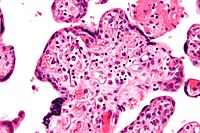
Photo from wikipedia
Background Worldwide, stillbirth is one of the leading causes of death. Altered fetal growth and placental abnormalities are the strongest and most prevalent known risk factors for stillbirth. The aim… Click to show full abstract
Background Worldwide, stillbirth is one of the leading causes of death. Altered fetal growth and placental abnormalities are the strongest and most prevalent known risk factors for stillbirth. The aim of this study was to identify patterns of association between placental abnormalities, fetal growth, and stillbirth. Methods and findings Population-based case-control study of all stillbirths and a representative sample of live births in 59 hospitals in 5 geographic areas in the U.S. Fetal growth abnormalities were categorized as small (<10th percentile) and large (>90th percentile) for gestational age at death (stillbirth) or delivery (live birth) using a published algorithm. Placental examination by perinatal pathologists was performed using a standardized protocol. Data were weighted to account for the sampling design. Among 319 singleton stillbirths and 1119 singleton live births at ≥24 weeks at death or delivery respectively, 25 placental findings were investigated. Fifteen findings were significantly associated with stillbirth. Ten of the 15 were also associated with fetal growth abnormalities (single umbilical artery; velamentous insertion; terminal villous immaturity; retroplacental hematoma; parenchymal infarction; intraparenchymal thrombus; avascular villi; placental edema; placental weight; ratio birth weight/placental weight) while 5 of the 15 associated with stillbirth were not associated with fetal growth abnormalities (acute chorioamnionitis of placental membranes; acute chorioamionitis of chorionic plate; chorionic plate vascular degenerative changes; perivillous, intervillous fibrin, fibrinoid deposition; fetal vascular thrombi in the chorionic plate). Five patterns were observed: placental findings associated with (1) stillbirth but not fetal growth abnormalities; (2) fetal growth abnormalities in stillbirths only; (3) fetal growth abnormalities in live births only; (4) fetal growth abnormalities in stillbirths and live births in a similar manner; (5) a different pattern of fetal growth abnormalities in stillbirths and live births. Conclusions The patterns of association between placental abnormalities, fetal growth, and stillbirth provide insights into the mechanism of impaired placental function and stillbirth. They also suggest implications for clinical care, especially for placental findings amenable to prenatal diagnosis using ultrasound that may be associated with term stillbirths.
Journal Title: PLoS ONE
Year Published: 2017
Link to full text (if available)
Share on Social Media: Sign Up to like & get
recommendations!